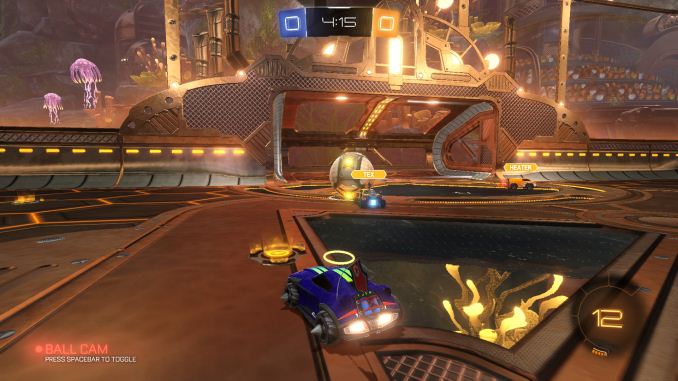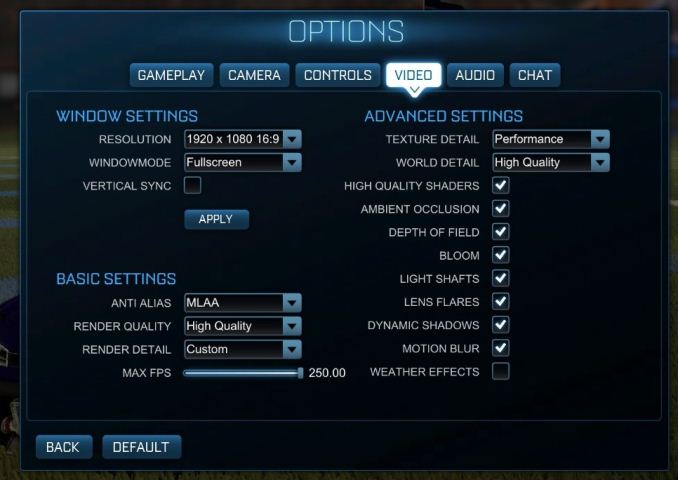Retesting AMD Ryzen Threadripper’s Game Mode: Halving Cores for More Performance
by Ian Cutress on August 17, 2017 12:01 PM ESTRocket League
Hilariously simple pick-up-and-play games are great fun. I'm a massive fan of the Katamari franchise for that reason — passing start on a controller and rolling around, picking up things to get bigger, is extremely simple. Until we get a PC version of Katamari that I can benchmark, we'll focus on Rocket League.
Rocket League combines the elements of pick-up-and-play, allowing users to jump into a game with other people (or bots) to play football with cars with zero rules. The title is built on Unreal Engine 3, which is somewhat old at this point, but it allows users to run the game on super-low-end systems while still taxing the big ones. Since the release in 2015, it has sold over 5 million copies and seems to be a fixture at LANs and game shows. Users who train get very serious, playing in teams and leagues with very few settings to configure, and everyone is on the same level. Rocket League is quickly becoming one of the favored titles for e-sports tournaments, especially when e-sports contests can be viewed directly from the game interface.
Based on these factors, plus the fact that it is an extremely fun title to load and play, we set out to find the best way to benchmark it. Unfortunately for the most part automatic benchmark modes for games are few and far between. Partly because of this, but also on the basis that it is built on the Unreal 3 engine, Rocket League does not have a benchmark mode. In this case, we have to develop a consistent run and record the frame rate.
Read our initial analysis on our Rocket League benchmark on low-end graphics here.
With Rocket League, there is no benchmark mode, so we have to perform a series of automated actions, similar to a racing game having a fixed number of laps. We take the following approach: Using Fraps to record the time taken to show each frame (and the overall frame rates), we use an automation tool to set up a consistent 4v4 bot match on easy, with the system applying a series of inputs throughout the run, such as switching camera angles and driving around.
It turns out that this method is nicely indicative of a real bot match, driving up walls, boosting and even putting in the odd assist, save and/or goal, as weird as that sounds for an automated set of commands. To maintain consistency, the commands we apply are not random but time-fixed, and we also keep the map the same (Aquadome, known to be a tough map for GPUs due to water/transparency) and the car customization constant. We start recording just after a match starts, and record for 4 minutes of game time (think 5 laps of a DIRT: Rally benchmark), with average frame rates, 99th percentile and frame times all provided.
The graphics settings for Rocket League come in four broad, generic settings: Low, Medium, High and High FXAA. There are advanced settings in place for shadows and details; however, for these tests, we keep to the generic settings. For both 1920x1080 and 4K resolutions, we test at the High preset with an unlimited frame cap.
All of our benchmark results can also be found in our benchmark engine, Bench.
MSI GTX 1080 Gaming 8G Performance

1080p



4K



Sapphire Nitro R9 Fury 4G Performance

1080p



4K



Sapphire Nitro RX 480 8G Performance

1080p



4K



With Ryzen, we encounted some odd performance issues when using NVIDIA-based video cards that caused those cards to significantly underperform. However equally strangely, the issues we have with Ryzen on Rocket League with NVIDIA GPUs seem to almost vanish when using Threadripper. Again, still no easy wins here as Intel seems to take Rocket League in its stride, but Game mode still helps the 1950X. The Time Under graphs give some cause for concern, with the 1950X consistently being at the bottom of that graph.












104 Comments
View All Comments
Gigaplex - Thursday, August 17, 2017 - link
How is Windows supposed to know when a specific app will run better with SMT enabled/disabled, NUMA, or even settings like SLI/Crossfire and PCIe lane distribution between peripheral cards? If your answer is app profiles based on benchmark testing, there's no way Microsoft will do that for all the near infinite configurations of hardware against all the Windows software out there. They've cut back on their own testing and fired most of their testing team. It's mostly customer beta testing instead.peevee - Friday, August 18, 2017 - link
Windows does not know whether it is a critical gaming thread or not. Setting thread affinity is not a rocket science - unless you are some Java "programmer".Spoelie - Friday, August 18, 2017 - link
And anyone not writing directly in assembly should be shot on sight, right?peevee - Friday, August 18, 2017 - link
You don't need to write in assembly to set thread affinities.Glock24 - Thursday, August 17, 2017 - link
Seems like the 1800X is a better all around CPU. If you really need and can use more than 8C/16T then get TR.For mixed workloads of gaming and productivity the 1800X or any of the smaller siblings is a better choice.
msroadkill612 - Friday, August 18, 2017 - link
The decision watershed is pcie3 lanes imo. Otherwise, the ryzen is a mighty advance in the mainstream sweet spot over ~6 months ago.OTH, I see lane hungry nvme ports as a boon to expanding a pcs abilities later. The premium for an 8 core TR & mobo over ryzen seems cost justifiable expandability.
Luckz - Friday, August 18, 2017 - link
It seems that the 1800X has the NVIDIA spend less time doing weird stuff.franzeal - Thursday, August 17, 2017 - link
If you're going to reference Intel in your benchmark summaries (Rocket League is one place I noticed it), either include them or don't forget to edit them out of your copy/paste job.Luckz - Friday, August 18, 2017 - link
WCCFTech-Level writing, eh.franzeal - Thursday, August 17, 2017 - link
Again, as with the original article, the description for the Dolphin render benchmarks is incorrectly stating that the results are shown in minutes.